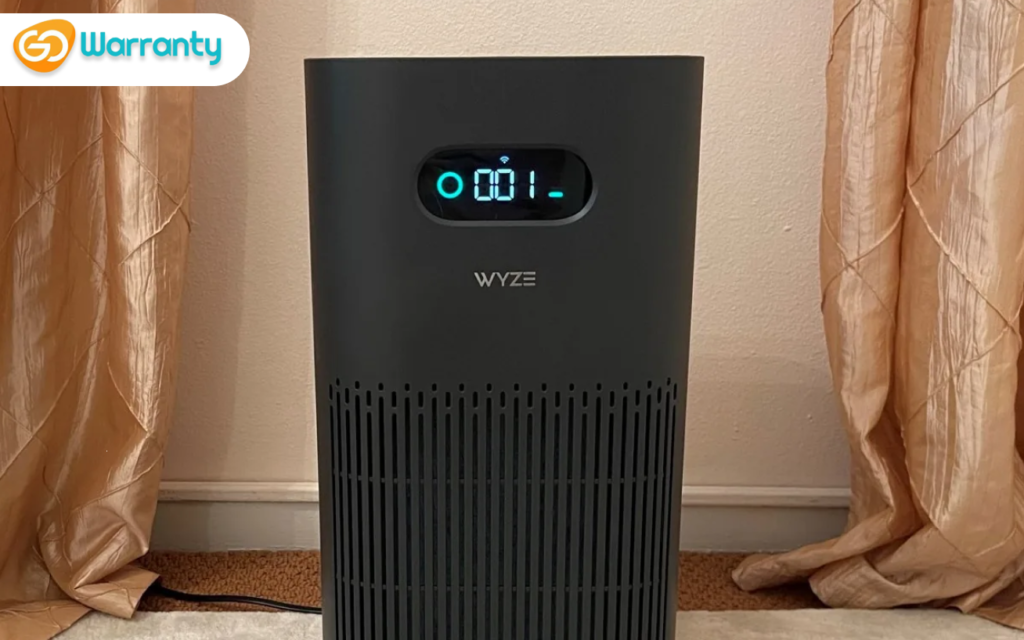If you’re worried about breathing in wildfire smoke, dangerous off-gases from new furniture, or pet dander, you should think about getting a smart air purifier. Most models suitable for large rooms are quite expensive, but the Wyze Air Purifier is a good value at $169.99. It has a 360-degree HEPA and activated carbon filter that promises to eliminate a variety of unwanted or harmful particles from the air in fairly large rooms. The unit is unsightly, but it runs quietly, has Wi-Fi connectivity for app and voice control, and provides basic air quality data. Most importantly, it filters the air just as well as much more expensive devices.
Connected Dyson models, such as the Editors’ Choice-winning Purifier Cool TP07 ($549.99), provide many extra benefits, such as an oscillating tower fan to keep you cool and individual measurements of various air pollutants. However, if you want to improve the quality of your indoor air without spending a fortune, the Wyze Air Purifier is a good option.
Wyze Air Purifier: Basics
Wyze is known for selling low-cost smart home devices, and its first air filtration product is no exception one of the least expensive models with Wi-Fi we’ve tested. The standard Allergen filter is preinstalled on the base model, but Wyze also provides this machine with a Wildfire filter for $174.99 or a Formaldehyde filter for $194.99. The company sent me a unit with a preinstalled Wildfire filter for this review. The circular filters are 11.3 by 8.1 inches in size (HD). They can be used interchangeably in the purifier.
True HEPA and activated carbon are used in all three filter options to remove particulate matter (microscopic particles) and gaseous pollutants such as bacteria, dust, mould, odours, pet allergens, pollen, tobacco smoke, viruses, as well as VOCs (volatile organic compounds, or potentially harmful gases from things like cleaning products and paint). True HEPA air filters must be capable of removing at least 99.97% of airborne particles as small as 0.3 microns.
According to Wyze, the Allergen filter is adequate for most common household air pollutants, while the Wildfire filter “is especially effective against smoke generated by wildfire, industrial processes, and traffic.”
A manganese catalyst layer is used in the Formaldehyde filter to more efficiently remove chemical gases such as VOCs and formaldehyde, which are released by many household items such as carpets, flooring, furniture, rugs, insulating materials, particleboard, plywood, paint, varnishes, and wallpapers. If you smoke or live with someone who does, have a new or recently remodelled home, or are redecorating, you may want to invest in a Formaldehyde filter.

Display and Fans
The Wyze Air Purifier has four fan speeds: Min, Mid, Max, & Turbo, as well as an Auto Mode that adjusts the fan speed based on the indoor air quality in real-time. The device includes a laser particle sensor that measures the density of PM2.5 particles (particulate matter smaller than 2.5 microns in size).
On the front, a small, oblong display shows the real-time indoor Air Quality Index (AQI) rating with a coloured ring and a number. Green (0 to 50) indicates good air quality, yellow (51 to 150) indicates moderate air pollution, and red (more than 150) indicates unhealthy air pollution.
Other Features
The Wyze Air Purifier does not come with a remote, but you can control it with your phone, your voice, or the device’s buttons. It has four buttons on top: On/Off, Auto Mode, Fan Speed (which allows you to cycle from slowest to fastest fan speed), and Sleep (turns the display off and sets the fan to the lowest speed). It also has a Child Lock to keep small hands from tampering with the buttons. To activate the Child Lock, hold down the Fan Speed and Sleep buttons for three seconds. When enabled, a lock icon appears on the screen.
App and Voice Control
Since the Wyze Air Purifier is Wi-Fi enabled, you can control it and monitor real-time indoor air quality from your phone using the Wyze app (available for Android and iOS).
It only took a few minutes to set up the Wyze Air Purifier and connect it to the Wyze mobile app during testing. To begin, download the Wyze app and, if you haven’t already, create an account. I use the Wyze app on a variety of Wyze smart devices, including the Bulb White, Bulb Colour, and Cam Floodlight, so I am very familiar with it; it typically provides a seamless setup experience, as is the case with the Air Purifier.
There are four buttons beneath the AQI ring: Auto, Sleep, Off, and Manual. The Manual button brings up a menu where you can toggle the Child Lock, adjust the fan speed, or set a timer to have the air purifier turn off after a certain amount of time (one hour, two hours, four hours, eight hours, or a custom duration up to 24 hours).
A light bulb icon in the app’s top right corner launches an Insights page that displays a graph of your indoor AQI history (PM2.5 levels) over the previous 24 hours. There will be no data on the graph if your air purifier was turned off during that time. Insights also display the density of various outdoor pollutants and pollens (grass, weed, and tree).
Verdict
A smart air purifier with app connectivity as well as a coverage area of more than 500 square feet can easily cost more than $500. The Wyze Air Purifier checks both boxes and costs only $169.99. It has four fan speeds and a 360-degree True HEPA filter, as well as an Auto mode that adjusts the airflow based on real-time pollution levels. The purifier also provides impressive purification performance for large rooms, and we appreciate the variety of filter options available. More expensive models, such as the Dyson Purifier Cool TP07, include an oscillating fan and additional measurements for humidity, NO2, PM10, temperature, and VOCs. However, at a much lower cost, the Wyze Air Purifier is an excellent alternative.

